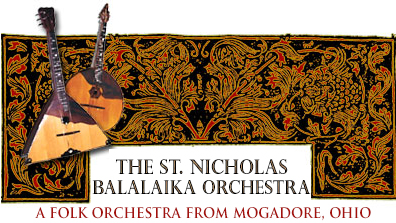|

Calendar of Events
Highlights of Past Seasons

Our Instruments
Our Costumes
History & Highlights
St. Nicholas Church
 Buy Our CD
Buy Our CD
Video
 Testimonials
Testimonials

Contact, volunteer, or join!

|
About Our Instruments
The instruments played by the St. Nicholas Balalaika Orchestra are the paintbrushes and canvases with which the eastern European peasant used to create the beautiful and poignant artistry of Slavic folk music so treasured today.
The orchestra features a variety of instruments to create its distinctive sound. At the forefront is the balalaika itself, the triangular, lute-like folk instrument. Typically containing three strings, the balalaika comes in a variety of sizes, each of which contributes a unique sound.
PRIMA BALALAIKA
The prima balalaika, the most popular size balalaika, is a melody instrument. It has a triangular soundboard with a beveled back and a long neck. The traditional balalaika has three strings that are tuned A, E, and E. All the strings of the prima balalaika are played at the same time, or in some combination thereof.
ALTO BALALAIKA
The alto balalaika, a harmony instrument, is used mainly for chord accompaniment. With its triangular soundboard, beveled back, and long neck, it looks quite similar to the prima except that it is larger in size. The alto has three strings that are tuned one octave lower than the prima balalaika, creating a deeper sound for the orchestra. Its strings are tuned to A, E, and E and are played at the same time, or in some combination thereof, using a plectrum.
BASS BALALAIKA
The deep sound of the bass balalaika likens it to the bass violin in a symphony orchestra. It too has the triangular soundboard, beveled back, and long neck, yet it is much greater in size than the alto and is supported on the floor with an end pin. Its three strings are tuned D, A, and E and are played with a plectrum.
CONTRA BASS BALALAIKA
The largest of the balalaikas, the contra bass balalaika again shares the triangular shape and beveled back with long neck. However, because of its size, it is supported on the floor with an end pin and is played standing upright. Its three strings, tuned D, A, and E, provide the deepest sound for the orchestra.
PRIMA DOMRA
The sister instrument of the balalaika, the prima domra has a round soundboard with a beveled back and long neck. Its three strings, tuned D, A, and E, are played independently of each other using a plectrum. Entrusted with the basic melodies in the upper registers, the prima domra can be likened to a violin in a symphony orchestra.
ALTO DOMRA
The alto domra is larger in size and deeper in tone than the prima domra. It has the same round soundboard with beveled back and long neck. Its three strings are tuned D, A, and E one octave lower than the prima domra. Its strings are played independently of each other using a plectrum. The alto domra can be compared to a viola in a symphony orchestra.
BASS DOMRA
The bass domra is larger in size and deeper in tone than the alto domra. It has the same round soundboard with a beveled back and a long neck. The bass domra has three strings which are tuned D, A, and E one octave lower than the alto domra. The strings of the bass domra are played independently of each other using a plectrum. The bass domra can be compared to a cello in a symphony orchestra.
PIANO GUSLI
There are only five piano guslis in the entire United States, so we are delighted to have one of them in our orchestra! The instrument has a keyboard that is only one octave; however, when the keys are depressed, the strings have a range of five octaves. The player manipulates the strings with a plectrum in a variety of sweeping and strumming motions.
ACCORDION
Most audience members recognize the accordion, the small, portable, free-reed wind instrument with a keyboard. The right hand plays the keys arranged in the order of the scale, like piano keys, while the left hand presses the buttons that produce single tones and chords. Its timbre provides a sharp contrast to the sound of the stringed instruments and contributes to the richness of the orchestra.
|

 Our Costumes
Our Costumes
 History & Highlights
History & Highlights

